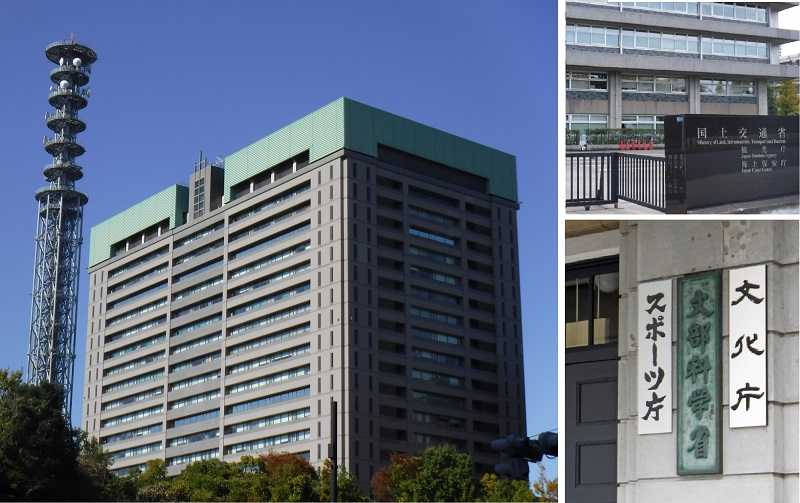Defense Perspective: Forward Reconnaissance / Include industry, academia and Coast Guard in all-hands approach

Clockwise from left; the Defense Ministry; the Land, Infrastructure, Transport and Tourism Ministry; the Education, Culture, Sports, Science, and Technology Ministry
7:00 JST, December 25, 2022
Japan has come to a turning point with the approval of three defense and security-related documents, including the new National Security Strategy. This is the second installment in a series examining the future direction of Japan’s security policy.
With international order being shaken, how can Japan create a desirable security environment for itself?
The National Security Strategy stresses that to address this issue, Japan needs a strategy that “integrates its national responses at a higher level by taking full advantage of comprehensive national power.”
The strategy states that “comprehensive national power” includes diplomatic, defense, economic, technological and intelligence capabilities. It is important to begin to mobilize these powers in shaping the nation’s security system, a task that so far has been left up to the Defense Ministry and the Self-Defense Forces. The strategy seeks to break down the bureaucratic sectionalism of ministries and agencies, and to promote joint academic, industrial and government efforts.
“This is the current world standard,” Prime Minister Fumio Kishida said to members of his inner circle on Dec. 16, the day the Cabinet approved three major security-related documents. “Japan could be left behind if we stick with classical diplomacy and security.”
To promote cross-ministry and agency efforts, the budget process will be reviewed.
In late October, Takeo Akiba, secretary general of the National Security Secretariat, met with vice-ministerial-level officials from ministries and agencies in the Cabinet Office.
The Education, Culture, Sports, Science and Technology Ministry accounts for about 50% of the government’s total budget for science and technology, while the Land, Infrastructure, Transport and Tourism Ministry is responsible for the construction and improvement of public infrastructure such as airports and seaports.
In the past, defense matters were not included in these ministries’ policies. Akiba bowed to the officials, saying, “I need your cooperation.”
The government aims to increase defense spending to a level equivalent to 2% of the nation’s gross domestic product by including expenses for research and development, public infrastructure, cyber security and international cooperation, as well as the Japan Coast Guard budget.
The budget will prioritize items based on the needs of the Defense Ministry, such as defense-related research and development and airport and seaport developments, in the allocation process.
Research and development can be called a symbolic field for enhancing Japan’s comprehensive national power. In most major countries around the world, industry, governments and academia cooperate in the development of technologies that can be used for both military and civilian purposes.
If advanced technologies adopted by the military can be used by the private sector, this will create a virtuous cycle and also contribute to economic growth.
However, Japan has lagged in this regard. Since the end of World War II, the Science Council of Japan has been opposed to conducting research that can be used for military purposes. Universities still tend to avoid military-related research.
The government is considering the use of independent administrative agencies off university campuses as research centers. The key is specific plans.
There is also an urgent need to boost cooperation between the SDF and the JCG, which is responsible for the security of waters around the Senkaku Islands in Okinawa Prefecture.
“It is an issue that has been left unresolved for many years,” Kishida said at a meeting of the House of Representatives Budget Committee on Nov. 28.
Under the Self-Defense Forces Law, the prime minister is authorized to place the JCG under the command of the defense minister if Japan is attacked by other countries, and to order the mobilization of the SDF for defense purposes.
Protocols to define relevant procedures must be compiled in preparation for such an emergency.
Under the Japan Coast Guard Law, the JCG cannot operate as a military force. There is reluctance in the JCG toward increased cooperation with the SDF in the event of an emergency. However, protocols are being drawn up in response to calls from Kishida and joint SDF-JCG drills will be conducted.
Japan’s declining defense industry must also be improved. The National Security Strategy characterizes defense production and technology bases as “defense capabilities themselves.”
The Implementation Guidelines for the Three Principles of Transfer of Defense Equipment and Technology, which have shackled exports of defense equipment, urgently need to be reviewed as the domestic market has reached a plateau.
To overcome its most challenging security environment since the end of World War II, Japan needs to mobilize its comprehensive power as the world’s third-largest economy. There is no time for empty slogans or bureaucratic sectionalism, which has created a gulf that divides industry, government and academia.
"Politics" POPULAR ARTICLE
-

Japan to Support Central Asian Logistics Route That Bypasses Russia, Plan to Be Part of Upcoming Summit in Tokyo
-

Japan to Tighten Screening of Foreigners’ Residential Status by Providing Information of Nonpayment of Taxes
-

Takaichi Cabinet Approval Holds at 72% as Voters Back Aggressive Fiscal Stimulus, Child Benefits
-

Chinese, Russian Bombers Flew Unusual Path by Heading Toward Tokyo; Move Likely Meant to Intimidate Japan
-

Takaichi Meets Many World Leaders at G20 Debut in Johannesburg; Speaks with Heads of Countries Including Italy, U.K., Germany, India
JN ACCESS RANKING
-

Keidanren Chairman Yoshinobu Tsutsui Visits Kashiwazaki-Kariwa Nuclear Power Plant; Inspects New Emergency Safety System
-

Imports of Rare Earths from China Facing Delays, May Be Caused by Deterioration of Japan-China Relations
-

University of Tokyo Professor Discusses Japanese Economic Security in Interview Ahead of Forum
-

Japan Pulls out of Vietnam Nuclear Project, Complicating Hanoi’s Power Plans
-

Govt Aims to Expand NISA Program Lineup, Abolish Age Restriction
























